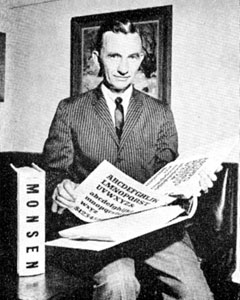Monsen’s Type Book Sets High Standard

Gordon Monsen, president of Monsen Typographers, Inc., displays the firm’s new type library, which has samples of over 1,000 type faces.
The profile this month changes from typographer to typographic tool—in this instance the new jumbo type specimen book issued by Monsen Typographers, Inc. of Chicago.¹
When Thormod Monsen, a Norwegian immigrant, established his printing firm in Chicago in 1887, the shop boasted a type library of 110 different types, a very adequate supply for the period. The firm’s first type specimen book was tablet size and contained 12 pages, the title page bearing the inscription that “Thormod Monsen Gives Special Attention to Composition and Transfer Impressions for the Lithographic Trade,” a prophetic introduction to what has become a major concern of most typographic plants.
1. See the book review in July Inland Printer/American Lithographer, page 116.)
Now, 25 specimen books later, Monsen has set a standard for the industry. Its new two-volume book contains more than 1,500 pages, showing over 1,000 types in every size which the shop carries. Included are characters used for Hebrew, Russian, and Greek, along with special accents for 42 languages other than English which utilize the Roman alphabet.
Monsen’s book is an indication of the evolution of the printer’s specimen book as a working tool for busy production people. It is no longer sufficient simply to list types. Modern specimen books are becoming production manuals and style books, which attempt to give every possible aid to the printer’s customers. With the cost of producing typography constantly spiraling upward, the printer must be conscious of the continuing need to lower production costs.
Standardized markup is a very necessary part of this concept. So what could be simpler than educating and informing the customer at the same time you show him the catalogs of your services? Thus, Monsen’s book gives hints on copyfitting and markup to meet its own requirements. Also included is a typographic glossary: facts about type sizes, styles, weights, widths, and a variety of other items about which lack of knowledge may contribute to wasted time and effort, and unnecessarily increased costs.
Contributing to the sheer bulk of this type catalog is the completeness of each type showing. Ideally, every type should be shown in full alphabet for every size listed, along with body copy for the keyboard sizes with at least three variations of leading.
This degree of thoroughness alone is probably the most controversial consideration in the design of the specimen book. Naturally enough, the cost of producing such a book is a criticism voiced most frequently by those printers who prefer a different procedure.
In limiting the distribution, Monsen has taken another step which is fast becoming an economic necessity in the production of specimen books. The firm will, of course, send the book to its customers, but inevitably there will be many requests for copies from other people who want to own such a splendid catalog. The book will be available to noncustomers and to “interested collectors” for the sum of $200. Since a secondary activity of any specimen book is to attract new customers, the Monsen book will perform this function, too. The book’s price will be refunded when a customer orders $3,000 worth of typesetting in a year’s period.
I can offer but one criticism of this well-conceived book: The classification of type styles leaves something to be desired. In this respect, no two printers’ specimens are alike. There is a need for a clear and understandable nomenclature of type styles, on a national level, and until this is accomplished, we will continue to have type catalogs which are inconsistent in organization. In spite of this, the Monsen book is a wonderful achievement.
This article first appeared in the August 1961 issue of The Inland Printer/American Lithographer.